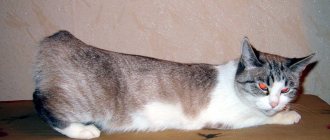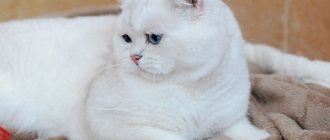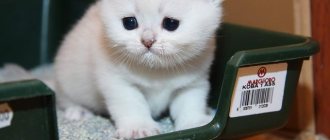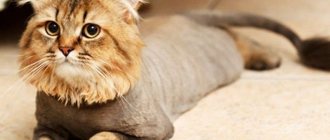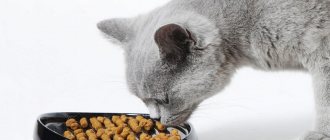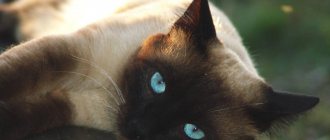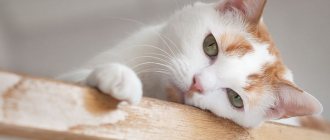When getting a pet, everyone understands that they will face a number of difficulties. However, few people think about the “mating season” of future pets. This topic deserves special attention; preparation is indispensable. So, what to do if the cat goes on a spree? The most important thing is not to panic.
It should be remembered that the animal senses the owner’s mood. Many people begin to think about how to get rid of the animal, because it is such a hassle. There is no need to show weakness, all problems can be solved. The main thing is to know how to do it. Having all the necessary information, you can help both the cat and yourself.
What is estrus
Estrus is a period during which a cat experiences hormonal, physiological and behavioral changes. They are associated with the female’s readiness to mate and bear offspring.
The period of estrus is accompanied by severe stress for the animal. The cat becomes restless, loses its appetite, constantly screams and looks for a male. It is during this period that cats are most prone to escape. Due to the effects of hormones, they are not able to adequately assess the danger, and therefore can even jump out of an open window from a high floor.
The period of estrus often becomes a real test for both the cat and its owner. It is worth noting that empty heats (if the cat has not mated and become pregnant) are very dangerous for the health of the animal. They often lead to inflammation of the ovaries, pyometra (a deadly disease), mammary gland cancer, and other disorders in the animal’s body.
That is why veterinarians often advise sterilizing all cats that do not have breeding value and do not participate in breeding. This will protect both the owner’s nerves and the health of his pet, and no more stray kittens will appear on the street.
First heat
Typically, a cat's first heat begins between 6 and 10 months of age. Sometimes a four-month-old kitten may go into heat, which is considered a deviation from the norm. In this case, the animal should be shown to a doctor. In some cases, estrus does not begin even after one and a half years of age. This is a signal that something is wrong with the cat's health.
Factors that influence when a cat goes into her first heat:
- Heredity.
- Animal size.
- The presence of a mature cat in the house.
- Health status.
- Does the cat have access to the outside? Outdoor cats often mature earlier. Since the average lifespan of street cats is shorter than that of domestic cats, they try to leave offspring as early as possible.
- Breed.
It is worth noting that a cat’s first estrus may be blurred, without obvious symptoms. The owner may not even know that his pet has already formed and is quite ready for mating. However, even during an asymptomatic period, a cat can become pregnant. This is why keeping kittens of different sexes older than six months together is somewhat risky.
Cat puberty occurs earlier than physical maturation. This is why you should not mate a female during her first heat: this can lead to a difficult pregnancy, problems during childbirth, and behavioral disorders (it happens that mothers who are too young do not want to take care of their kittens).
Often, breeders mate cats for the first time at the age of one and a half years, when the female has already gone through 2-3 heats. At this age, the cat is already old enough, and the risks of pregnancy are minimized.
Symptoms and features of estrus
The onset of estrus is often accompanied by a change in the animal's behavior. During this period, the cat has practically no control over its behavior; it is under the complete power of instincts. This is why even the most well-mannered, but unsterilized, cats during the period of estrus often begin to go to the toilet in a place other than the litter tray. They mark their territory with their scent, thus attracting males.
We recommend the article: What causes bumps on the nose of cats?
The cat's egestive cycle is divided into several phases, which have their own symptoms:
- Precursor or proestrus. Hormonal changes begin to occur in the animal's body. A cat may become too affectionate and constantly ask for attention from its owner. At the same time, she is not yet ready for mating, and therefore does not allow cats to approach her and can react quite aggressively to them.
- Estrus or estrus. Swelling of the genital organs can be observed, and light, clear discharge is possible. The cat often licks itself under its tail. She behaves restlessly, rubbing herself against furniture, walls and her owner’s legs. The cat can press itself to the floor and raise its tail, inviting the male to mate. Often this period is accompanied by screams that do not stop day or night. The cat's appetite decreases. During this period, the animal may lose weight.
- Afterflow or metestrus. The cat no longer allows males to approach her. Often during this period she may already be pregnant. Sometimes after estrus in cats a state of false pregnancy occurs. If pregnancy does not occur, the hormonal levels gradually return to normal, and sexual desire subsides.
- Interestrus or Anestrus. This is a period of rest that occurs between heats. The animal is completely calm, all symptoms of estrus are completely absent. The cat shows no interest in cats.
In some cases, symptoms of estrus remain unexpressed. The owners may even be pleased with this course of events, because the behavior of the pet during a special period does not change at all. However, the absence of symptoms of estrus may indicate a malfunction of the animal's body. In addition, even cats with relatively calm heats are still at risk. They are susceptible to various diseases of the reproductive system.
If a cat is involved in breeding, but her estrus is mild, contact with a sexually mature cat can often change the situation. After this, the symptoms of estrus should become more pronounced. In some situations, the veterinarian may prescribe hormonal medications to the animal, which will help establish a normal estrus cycle.
What is estrus?
The word "estrus" is the scientific name for estrus. During estrus, psychophysiological changes occur in the body. Follicles mature in the animal’s ovaries, ovulation occurs, and conception becomes possible. During estrus, your pet's behavior changes noticeably.
The following signs indicate that a cat is walking:
- The pet becomes overly affectionate, or, conversely, shows inexplicable aggression.
- Meows loudly and invitingly. During estrus, a cat can call for a male for days. Read the article “Why does a cat constantly meow and yell throughout the day?”
- Frequent urination due to physiological changes in the body.
- The presence of clear discharge on the genitals. Therefore, your pet will lick itself more often.
- There is also a decrease in appetite. For some, interest in food may disappear altogether. This condition can occur in the first few days of estrus. Although some people may experience worsening appetite throughout the entire estrus phase.
- The genitals may be slightly swollen. But often only an experienced veterinarian can recognize this.
- Changes in gait. The cat bends its front legs halfway, raises the back of its body, lifts its tail or moves it to the side.
- The cat may begin to mark its territory.
These signs can be observed alternately or in combination.
Frequency and duration of estrus
The body of each animal is individual, therefore it is impossible to determine the exact timing and frequency of estrus in an individual cat. However, there are approximate dates that the sexual cycle of an animal should normally correspond to. A cat's heat can last from 6 to 10 days. Some cats can be in the period of active sexual hunting for up to 20 days. The duration of estrus is influenced by many factors. In young animals, heat can last only a couple of days. With age, the cycle will return to normal. Also, the duration of estrus depends on the weight of the animal, breed, living conditions, and state of health.
The frequency of estrus depends on the following factors:
- Health status.
- Breed. In Siamese and Persian breeds, estrus occurs every three weeks, but in British and Scottish breeds, the resting period can be up to 3 months.
- Conditions of detention.
- How quality is the food?
- Season. In winter, cats begin a long period of rest, but in the spring the frequency of estrus resumes. However, in animals that live in warm rooms around the clock, the frequency of estrus does not depend on the time of year. They are often ready to mate all year round.
- Heredity.
- Excess weight or excessive thinness.
- Stress. If the cat is in a stressful environment, estrus may stop altogether.
- Age of the cat. The older she is, the less often estrus occurs.
We recommend the article: Ringworm in cats: types and main signs, treatment and prevention
If a cat becomes pregnant during estrus, the next heat will begin only three months after the kittens are born. Although there are cases when a cat becomes ready to reproduce immediately after giving birth. It also happens that a false pregnancy may occur as a result of estrus. All symptoms indicate that the cat is expecting kittens, and the cat herself is sure of this, and therefore she begins to actively prepare for future motherhood. In this case, the cycle may also be slightly disrupted.
How long and often do cats walk?
Many owners are concerned about how much the cat walks and how often. It is difficult to give specific answers to these questions. Each representative of the cat family will have its own indicators. In addition, several factors influence the duration and frequency of estrus.
How many days a cat's heat lasts depends on:
- environmental conditions, season;
- conditions of detention;
- feeding characteristics;
- animal breeds;
- age of the cat;
- presence of contacts with cats;
- physiological characteristics of the pet’s body;
- health status.
True, there are averages. From 5 to 10 days - this is how long the estrus lasts for a cat living at home. But everything is individual. In rare cases, estrus can last up to 20 days. The first heat is most often short-lived and becomes longer over time. So, the number of days a cat walks for the first time does not mean that her estrus will continue to be of the same duration. The hormonal background has not yet fully formed.
It is recommended to observe how many days the cat is in heat, because sometimes it can be too long. And prolonged estrus is a pathology. Similar situations can occur with an ovarian tumor or cystic process. It is highly undesirable to start such diseases. Therefore, it is important to know how long a cat’s heat is normally. And in case of deviations, contact a veterinary clinic in a timely manner. The doctor will perform an ultrasound, take blood samples and, if necessary, prescribe a treatment regimen.
Sometimes it happens that the cat does not leak at all. This may be the cause of the development of some disease. Therefore, a visit to the veterinarian cannot be avoided. If the cat does not start walking, experienced breeders advise taking the following measures:
- If there is another cat who is currently in heat, she should be placed with a pet who is not starting to walk. Often cats leak at the same time. And the second one may also leak.
- If you have a cat, it is advisable to place it with a cat. The smell of a cat can cause hormonal changes in the pet's body, and the pet will begin to walk.
- You can give your pet vitamins and homeopathic remedies. Naturally, on the recommendation of a veterinarian. This method is only suitable for healthy cats.
The question of how long a cat’s first heat lasts is clear. But how often does the animal walk? As for frequency, if the cat has already given birth, then, as a rule, estrus occurs once every few months. Sometimes the interval can reach a year. But if your pet has not given birth before, estrus may bother you more often. For example, monthly or even every 2 weeks. As for stray animals, as well as older individuals, their estrus usually occurs in the fall or spring.
The question of why a cat often walks is understandable. But what to do in this situation? The best option is to give the animal the opportunity to reproduce regularly. Thus, it is possible to achieve that the heat will occur once every six months. But it is worth noting that a cat’s first heat after giving birth may appear after just 1-1.5 months. If the owner does not plan to breed cats at all, it is worth contacting a veterinarian. The animal can be sterilized. Or the doctor can choose hormonal drugs.
How to calm a cat during heat
First of all, the owner should immediately decide whether his pet will participate in breeding. It should be noted that childbirth is a rather complex process. Some owners believe that childbirth will only benefit their pet. But this is far from true. Pregnancy consumes a lot of resources, it wears out the body. In addition, pregnancy is accompanied by various risks, which may well lead to the death of the mother and cubs. This is why you should not breed animals that have no breeding value. Pregnancy will not bring any benefit to the cat itself, and outbred kittens often end up on the street.
If the cat will not participate in breeding, it should be sterilized. Moreover, it is advisable to do this before the age of one. At this age, the animal’s body has not yet encountered hormonal storms. The uterus is small in size, it can be easily removed, and the animal will quickly recover after the operation. But it is worth noting that surgery done too early can lead to problems with urination in the animal. Therefore, it is advisable to sterilize a cat at the age of 6-7 months.
If the cat does not participate in breeding, or it cannot be sterilized for some reason, then there are other ways to help the pet. During this period, the cat really needs affection and attention. The pet should be petted more often and treated affectionately.
Even if the cat does not behave quite adequately, you should be patient. You shouldn't scold her. The cat cannot control some of its impulses, and it is not her fault. Taking your anger out on an animal, beating it, scolding it is not worth it. This can lead to mental disorders, due to which the cat may begin to behave inappropriately not only during periods of heat.
There are medications that can calm the animal. They are often made from various plant components. Such medications act as a sedative, but they do not stop the estrus itself. You should consult your doctor before giving your cat any medications. Some of them are not at all harmless - they can cause drowsiness and seriously affect the behavior and health of the animal.
There are also hormonal drugs. They are just capable of completely stopping estrus. But using them is strictly not recommended. Such medications lead to various diseases of the cat’s reproductive system. Hormonal drugs are good for the owner, since due to their effect the animal does not go into sexual heat. But these medications have a negative effect on the health of the animal, and therefore they should be purchased only as prescribed by a doctor.
Hormonal drugs: benefits and harms
Veterinary pharmacies offer tablets and drops that relieve symptoms of estrus. They have a calming effect and will help you survive the period of estrus. But such means will help the person first of all - you will not be annoyed by incessant meowing and inappropriate affection. Calming drugs affect the cat’s hormonal levels, inhibiting them. There will be nothing useful from such a product for the cat’s health. They should be given with extreme caution! They are strictly prohibited for young animals under the age of five; in all other cases they are given only sporadically, as an exception. You cannot “comfort” a cat during every heat!
Hormonal drugs have the power to, among other things, delay or stop an estrus that has already begun. In some circumstances, this is convenient for the animal owner, but such treatment has a very negative effect on the cat’s health. And even more so, you can’t take them haphazardly!
Hormonal medications can only be taken as prescribed by a veterinarian, after tests show a hormonal imbalance. The background is leveled with homeopathic remedies that normalize female feline health. Homeopathic remedies include infusions and drops that calm the cat. They are used strictly according to the instructions and only after reaching a certain age.
A sterilized cat is in heat
It happens that even sterilized cats continue their estrus cycle. There may be several reasons for this:
- The operation was performed incorrectly.
- The ovaries were not removed, or ovarian tissue remained in the abdominal cavity.
- Sex hormones are secreted by a tumor, which can be located in the uterus, mammary glands, adrenal gland, or pituitary gland.
- The adrenal glands and pituitary gland continue to produce sex hormones even after the ovaries are removed.
We recommend the article: Rectal prolapse in cats: treatment, prevention measures
Often, the attenuation of sexual behavior does not occur immediately after sterilization. Sex hormones still circulate in the cat’s body, which lead to behavioral abnormalities. Sexual behavior subsides approximately 2-8 weeks after surgery. But in some animals it can last much longer. This is especially true for cats that have been spayed during estrus.
The age of the cat also affects how quickly the animal's behavior is corrected. The more heats a cat has experienced, the older she is, the greater the chance that sex hormones will begin to be actively secreted not only by the ovaries, but also by other glands. This means that late sterilization of a cat may not be effective in correcting the animal’s behavior. The cat will not be able to become pregnant after the operation, but signs of sexual heat will continue to be observed in the future.

